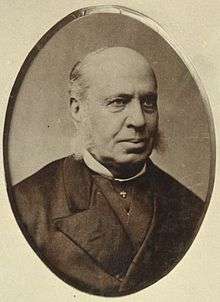Philip Santo
| Philip Santo | |
|---|---|
 | |
| South Australian Commissioner of Public Works | |
|
In office 8 October 1861 – 17 October 1861 | |
| Premier | George Waterhouse |
| Preceded by | Alexander Hay |
| Succeeded by | John Lindsay |
|
In office 15 July 1863 – 4 August 1864 | |
| Premier | Henry Ayers |
| Preceded by | William Townsend |
| Succeeded by | William Milne |
|
In office 20 September 1865 – 23 October 1865 | |
| Premier | Henry Ayers |
| Preceded by | Francis Dutton |
| Succeeded by | Thomas English |
|
In office 3 May 1867 – 24 September 1868 | |
| Premier | Henry Ayers |
| Preceded by | Thomas English |
| Succeeded by | William Everard |
|
In office 13 October 1868 – 3 November 1868 | |
| Premier | Henry Ayers |
| Preceded by | William Everard |
| Succeeded by | John Colton |
| Personal details | |
| Born |
7 August 1818 Saltash, Cornwall, England |
| Died |
17 December 1889 (aged 71) Adelaide, South Australia |
| Spouse(s) | Elizabeth Pean |
Philip Santo (7 August 1818 – 17 December 1889) was a South Australian politician and businessman.
History
Santo was born at Saltash, Cornwall, and trained to be a carpenter. At the age of 22 he left for South Australia on the ship Brightman, arriving in Adelaide in December 1840. He worked as a builder in Adelaide, then Burra. He moved to Melbourne during the rush to the Victorian goldfields but soon returned to set up a shop in Grote Street near Victoria Square in 1857, then Waymouth Street from 1866, then from 1873 as Philip Santo & Co in Waymouth Street and Lipson Street Port Adelaide; initially selling timber. then building materials then general hardware, riverboats and ships. By 1880 they had diversified into such disparate goods as patent medicines, perfumes and flavourings, American waggons, brooms, "kerosine", "gasoline" and cabinet organs.[1] The company ceased advertising around 1890.
Santo was elected to the South Australian House of Assembly in 1860 for the City of Adelaide district, 1862 and 1865 for East Adelaide then in 1868 for Barossa and was appointed Commissioner of Public works on a number of occasions for various periods, first in the Waterhouse cabinet, then with Henry Ayers to 1868. He lost his seat in 1870, during which year he was elected to the Legislative Council and held that seat for 21 years.[2] He was an active member of the Church of Christ, Grote Street and frequently preached there as an Elder. He died at his home, "Fernleigh House" on West Terrace, Adelaide.[3]
Family
Santo married Elizabeth Pean (23 September 1816 – 28 February 1904); they had four daughters and one son:
- Mary Maynard Santo (1841–1941) married James Shaw Greer (1835–1890), later mayor of Unley
- Elizabeth Hooper Santo (1845–1923) married James Smith (c. 1842–1900), a business partner of P. Santo, lived at Semaphore
- Jane Santo (1848–1875) married Rev. Thomas Jefferson Gore MA (1839–1923) of the Grote St. church
- Sarah Santo (1850–1945) married Rev. Thomas Jefferson Gore MA (1839–1923) on 5 October 1876
- Esther Santo (1852–1941)
- Philip Santo, Jr., (11 December 1842 – 13 June 1868) married Albertina Kidner (c. 1845 – 10 December 1909) on 9 October 1866. Philip was a prize-winning student at Adelaide Educational Institution, and worked for a time in his father's shop, but died at an early age from diphtheria,[4] leaving a wife and two daughters, Albertina Mary Santo and Amelia Elizabeth Santo (both married Messent boys). His widow, Albertina, married Dr. W. J. Torr on 20 December 1892.
References
- ↑ General Merchandise South Australian Advertiser 5 April 1886 p.8
- ↑ Death of Mr. Philip Santo The Advertiser 18 December 1889 p.5 accessed 15 April 2011
- ↑ Death of Hon. P. Santo South Australian Register 18 December 1889 p.6 accessed 16 April 2011
- ↑ http://saobits.gravesecrets.net/s.html